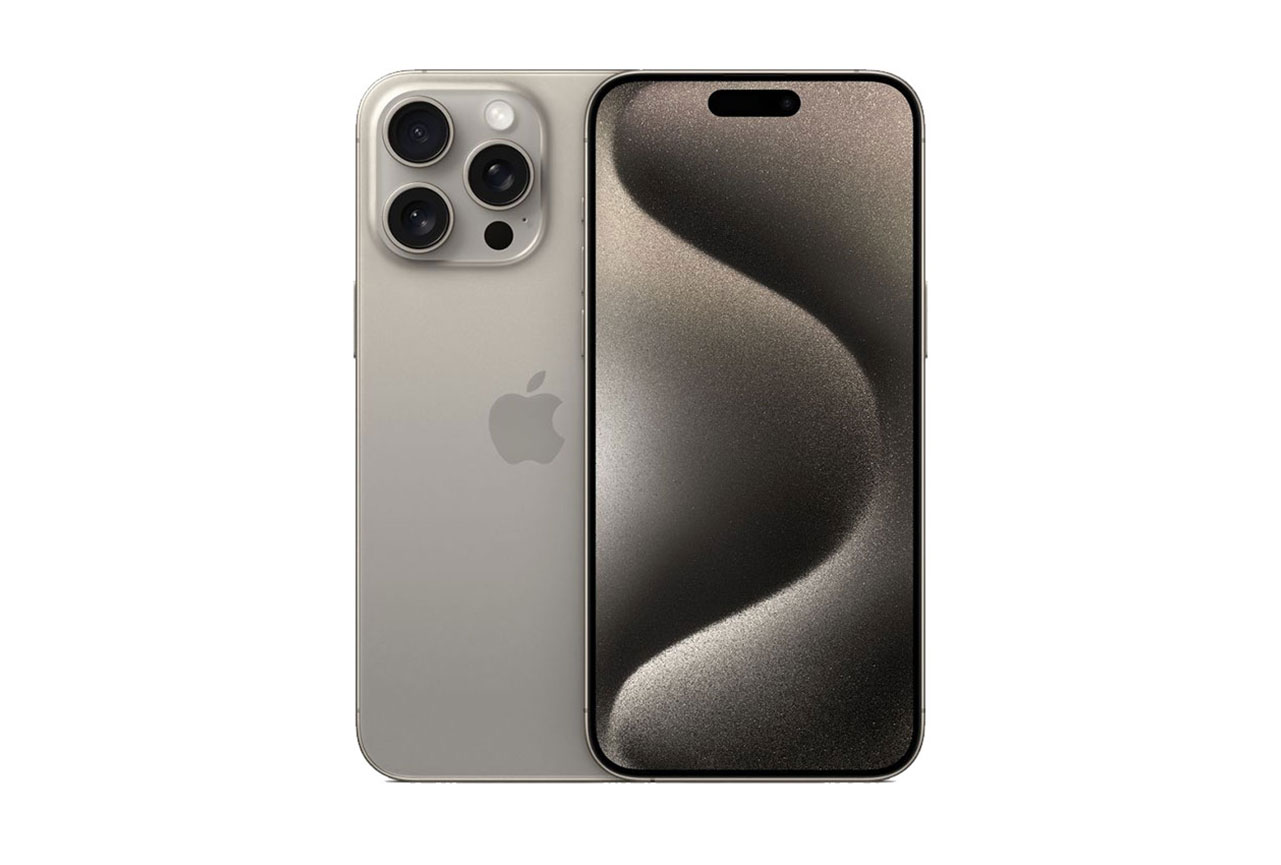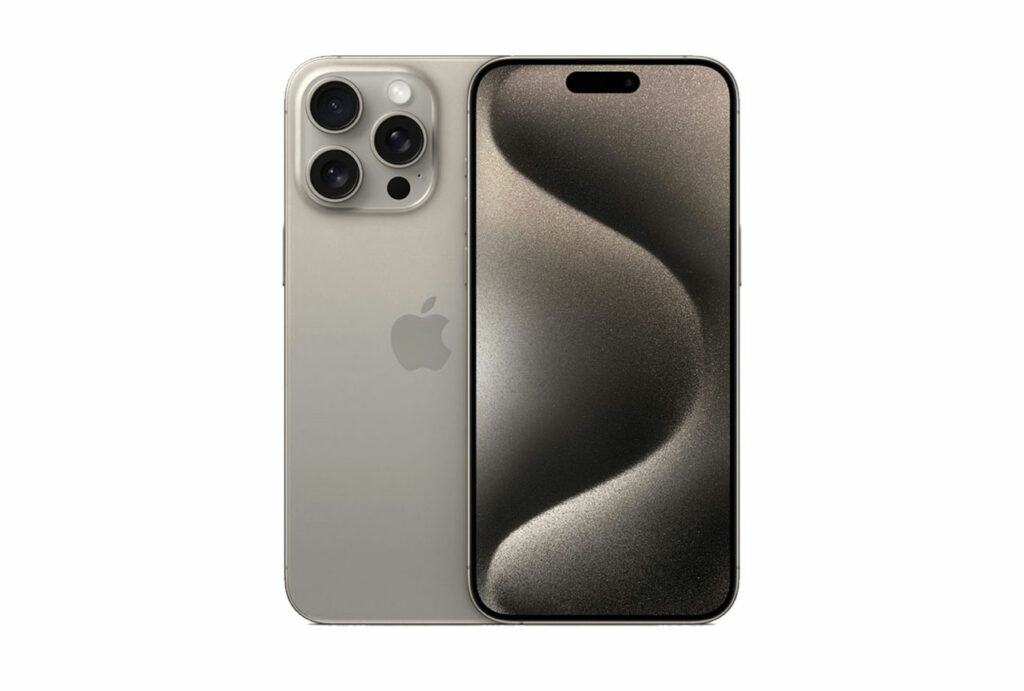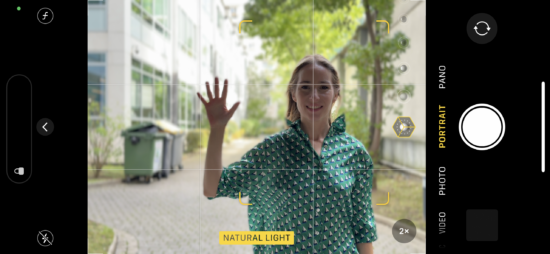We put the Apple iPhone 15 Pro through our rigorous DXOMARK Camera test suite to measure its performance in photo, video, and zoom quality from an end-user perspective. This article breaks down how the device fared in a variety of tests and several common use cases and is intended to highlight the most important results of our testing with an extract of the captured data.
Overview
Key camera specifications:
- Primary: 48MP sensor, 2.44µm quad pixels, 24mm equivalent f/1.78-aperture lens, Dual Pixel AF, OIS
- Ultra-wide: 12MP sensor, 13mm equivalent, f/2.2-aperture lens, Dual Pixel AF
- Tele: 12MP sensor, 1.0µm pixels, 77mm equivalent f/2.8-aperture lens
- A17 Pro chipset
Scoring
Sub-scores and attributes included in the calculations of the global score.

Apple iPhone 15 Pro


Use cases & Conditions
Use case scores indicate the product performance in specific situations. They are not included in the overall score calculations.
Outdoor
Photos & videos shot in bright light conditions (≥1000 lux)
Indoor
Photos & videos shot in good lighting conditions (≥100lux)
Lowlight
Photos & videos shot in low lighting conditions (<100 lux)
Friends & Family
Portrait and group photo & videos
Pros
- Vivid brightness and contrast when photos are viewed on HDR display
- Accurate exposure, even in night shots
- Pleasant and natural color rendering and skin tones
- Excellent detail in bright light
- Fast and accurate autofocus
- Effective video stabilization
The Apple iPhone 15 Pro delivered an excellent performance in the DXOMARK Camera tests, achieving the same score as the flagship model iPhone 15 Pro Max and securing a position among the best in our ranking.
With identical Quad-Bayer image sensors in the main camera, and chipsets, both still image and video quality were very similar between the 15 Pro and Pro Max. However, the two devices use different tele cameras, so it’s not much of a surprise that tele zoom performance was an exception. The Pro Max uses a 5x periscope design, the Pro comes with a more conventional 3x tele camera. While performance was very similar at close range tele, the Pro did better at medium range and the Pro Max was best for long-range tele shots. Overall, the 15 Pro scored slightly lower in the zoom category than the 15 Pro Max. However, the minor difference in zoom between the models had no effect on the overall score, which was identical for the two, because of the zoom score’s lighter weighting in our camera-scoring system. The Camera protocol’s score structure and the formula are presented in detail in an article that takes a closer look at how we test smartphone cameras.
Test summary
About DXOMARK Camera tests: DXOMARK’s Camera evaluations take place in laboratories and in real-world situations using a wide variety of subjects. The scores rely on objective tests for which the results are calculated directly by measurement software on our laboratory setups, and on perceptual tests in which a sophisticated set of metrics allow a panel of image experts to compare aspects of image quality that require human judgment. Testing a smartphone involves a team of engineers and technicians for about a week. Photo, Zoom, and Video quality are scored separately and then combined into an Overall score for comparison among the cameras in different devices. For more information about the DXOMARK Camera protocol, click here. More details on smartphone camera scores are available here. The following section gathers key elements of DXOMARK’s exhaustive tests and analyses. Full performance evaluations are available upon request. Please contact us on how to receive a full report.
Photo
Apple iPhone 15 Pro
169
For scoring and analysis, DXOMARK engineers capture and evaluate more than 2,600 test images both in controlled lab environments and in outdoor, indoor and low-light natural scenes, using the camera’s default settings. The photo protocol is designed to take into account the main use cases and is based on typical shooting scenarios, such as portraits, family, and landscape photography. The evaluation is performed by visually inspecting images against a reference of natural scenes, and by running objective measurements on images of charts captured in the lab under different lighting conditions from 1 to 1,000+ lux and color temperatures from 2,300K to 6,500K.
The iPhone 15 Pro’s performance in still image mode was on par with what we had previously seen on the flagship 15 Pro Max, with the Smart HDR feature boosting color, contrast and brightness for a very vivid overall image rendering. In addition, our testers found the levels of captured detail to be very high, especially on portrait shots, where very fine detail in facial features, such as skin texture and eyelashes, was very well preserved. Image noise was overall well under control, but our experts observed some luminance noise in the shadow areas of the frame. This was particularly true for low-light conditions, where the noise had a more grainy appearance.

Exposure
Apple iPhone 15 Pro
130

Color
Apple iPhone 15 Pro
130
Exposure and color are the key attributes for technically good pictures. For exposure, the main attribute evaluated is the brightness of the main subject through various use cases such as landscape, portrait, or still life. Other factors evaluated are the contrast and the dynamic range, eg. the ability to render visible details in both bright and dark areas of the image. Repeatability is also important because it demonstrates the camera's ability to provide the same rendering when shooting several images of the same scene.
For color, the image quality attributes analyzed are skin-tone rendering, white balance, color shading, and repeatability. For color and skin tone rendering, we penalize unnatural colors but we respect a manufacturer's choice of color signature.

Autofocus
Apple iPhone 15 Pro
125
Autofocus tests concentrate on focus accuracy, focus repeatability, shooting time delay, and depth of field. Shooting delay is the difference between the time the user presses the capture button and the time the image is actually taken. It includes focusing speed and the capability of the device to capture images at the right time, what is called 'zero shutter lag' capability. Even if a shallow depth of field can be pleasant for a single subject portrait or close-up shot, it can also be a problem in some specific conditions such as group portraits; Both situations are tested. Focus accuracy is also evaluated in all the real-life images taken, from infinity to close-up objects and in low light to outdoor conditions.
The iPhone 15 Pro largely maintained the level of autofocus performance that we already had seen on the predecessor, including zero shutter lag in most shooting conditions. This means that the camera is capable of capturing an image at exactly the moment the shutter is pressed, reducing the risk of missing the decisive moment.
Only in very challenging low-light conditions did our testers observe a slight delay to ensure good image all around image quality.

Texture
Apple iPhone 15 Pro
125
Texture tests analyze the level of details and the texture of subjects in the images taken in the lab as well as in real-life scenarios. For natural shots, particular attention is paid to the level of details in the bright and dark areas of the image. Objective measurements are performed on chart images taken in various lighting conditions from 1 to 1000 lux and different kinds of dynamic range conditions. The charts used are the proprietary DXOMARK chart (DMC) and the Dead Leaves chart.

Noise
Apple iPhone 15 Pro
117
Noise tests analyze various attributes of noise such as intensity, chromaticity, grain, structure on real-life images as well as images of charts taken in the lab. For natural images, particular attention is paid to the noise on faces, landscapes, but also on dark areas and high dynamic range conditions. Noise on moving objects is also evaluated on natural images. Objective measurements are performed on images of charts taken in various conditions from 1 to 1000 lux and different kinds of dynamic range conditions. The chart used is the Dead Leaves chart and the standardized measurement such as Visual Noise derived from ISO 15739.

Artifacts
Apple iPhone 15 Pro
82
The artifacts evaluation looks at lens shading, chromatic aberrations, geometrical distortion, edges ringing, halos, ghosting, quantization, unexpected color hue shifts, among others type of possible unnatural effects on photos. The more severe and the more frequent the artifact, the higher the point deduction on the score. The main artifacts observed and corresponding point loss are listed below.
Bokeh
Apple iPhone 15 Pro
85
Bokeh is tested in one dedicated mode, usually portrait or aperture mode, and analyzed by visually inspecting all the images captured in the lab and in natural conditions. The goal is to reproduce portrait photography comparable to one taken with a DLSR and a wide aperture. The main image quality attributes paid attention to are depth estimation, artifacts, blur gradient, and the shape of the bokeh blur spotlights. Portrait image quality attributes (exposure, color, texture) are also taken into account.
Preview
Apple iPhone 15 Pro
93
Preview tests analyze the image quality of the camera app's preview of the image, with particular attention paid to the difference between the capture and the preview, especially regarding dynamic range and the application of the bokeh effect. Also evaluated is the smoothness of the exposure, color and focus adaptation when zooming from the minimal to the maximal zoom factor available. The preview frame rate is measured using the LED Universal Timer.
Zoom
Apple iPhone 15 Pro
169
DXOMARK engineers capture and evaluate over 400 test images in controlled lab environments and in outdoor, indoor, and low-light natural scenes, using the camera’s default settings and pinch zoom at various zoom factors from ultra wide to very long-range zoom. The evaluation is performed by visually inspecting the images against a reference of natural scenes, and by running objective measurements of chart mages captured in the lab under different conditions from 20 to 1000 lux and color temperatures from 2300K to 6500K.
Instead of the Pro Max’s 5x periscope tele lens, the iPhone 15 Pro comes with a more conventional 3x variant. Despite the hardware differences, at close range, both phones rely on the main camera for tele zoom, and image quality was similar between the phones. However, at medium range, the 15 Pro delivered better detail, as the Pro Max tele lens only takes over at an equivalent focal lens of 120mm. Thanks to its 3x tele camera, the 15 Pro also delivered a quite consistent level of detail across the tele zoom range.

Wide
Apple iPhone 15 Pro
122
These tests analyze the performance of the ultra-wide camera at several focal lengths from 12 mm to 20 mm. All image quality attributes are evaluated, with particular attention paid to such artifacts as chromatic aberrations, lens softness, and distortion. Pictures below are an extract of tested scenes.

Tele
Apple iPhone 15 Pro
128
All image quality attributes are evaluated at focal lengths from approximately 40 mm to 300 mm, with particular attention paid to texture and detail. The score is derived from a number of objective measurements in the lab and perceptual analysis of real-life images.
At close range, the tele performance of the iPhone 15 Pro and iPhone 15 Pro Max were similar.
At medium range, around a 3x tele zoom factor, image results were better on the iPhone 15 Pro than on the Pro Max.
Video
Apple iPhone 15 Pro
159
DXOMARK engineers capture and evaluate more than 2.5 hours of video in controlled lab environments and in natural low-light, indoor and outdoor scenes, using the camera’s default settings. The evaluation consists of visually inspecting natural videos taken in various conditions and running objective measurements on videos of charts recorded in the lab under different conditions from 1 to 1000+ lux and color temperatures from 2,300K to 6,500K.
Like the Pro Max, the iPhone 15 Pro was tested with 4K resolution, 60fps variable frame rate and Dolby vision activated for embedded HDR data. This configuration produced excellent results, similar to what we observed for the iPhone 15 Pro Max. Just like for any HDR video enabled device, a compatible HDR display is required to see the full potential of the HDR rendering. Please note that YouTube only displays the original HDR rendering if videos are watched on a compatible HDR screen. Otherwise, a compressed SDR video is displayed.

Color
Apple iPhone 15 Pro
120
Exposure tests evaluate the brightness of the main subject and the dynamic range, eg. the ability to render visible details in both bright and dark areas of the image. Stability and temporal adaption of the exposure are also analyzed.
Image-quality color analysis looks at color rendering, skin-tone rendering, white balance, color shading, stability of the white balance and its adaption when light is changing.

Texture
Apple iPhone 15 Pro
118
Texture tests analyze the level of details and texture of the real-life videos as well as the videos of charts recorded in the lab. Natural videos recordings are visually evaluated, with particular attention paid to the level of details in the bright and areas as well as in the dark. Objective measurements are performed of images of charts taken in various conditions from 1 to 1000 lux. The charts used are the DXOMARK chart (DMC) and Dead Leaves chart.

Noise
Apple iPhone 15 Pro
120
Noise tests analyze various attributes of noise such as intensity, chromaticity, grain, structure, temporal aspects on real-life video recording as well as videos of charts taken in the lab. Natural videos are visually evaluated, with particular attention paid to the noise in the dark areas and high dynamic range conditions. Objective measurements are performed on the videos of charts recorded in various conditions from 1 to 1000 lux. The chart used is the DXOMARK visual noise chart.

Stabilization
Apple iPhone 15 Pro
119
Stabilization evaluation tests the ability of the device to stabilize footage thanks to software or hardware technologies such as OIS, EIS, or any others means. The evaluation looks at residual motion, smoothness, jellow artifacts and residual motion blur on walk and run use cases in various lighting conditions. The video below is an extract from one of the tested scenes.

Artifacts
Apple iPhone 15 Pro
86
Artifacts are evaluated with MTF and ringing measurements on the SFR chart in the lab as well as frame-rate measurements using the LED Universal Timer. Natural videos are visually evaluated by paying particular attention to artifacts such as aliasing, quantization, blocking, and hue shift, among others. The more severe and the more frequent the artifact, the higher the point deduction from the score. The main artifacts and corresponding point loss are listed below.















DXOMARK encourages its readers to share comments on the articles. To read or post comments, Disqus cookies are required. Change your Cookies Preferences and read more about our Comment Policy.